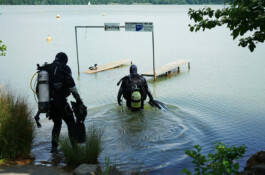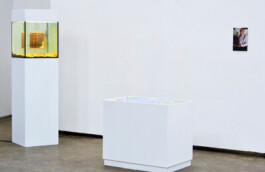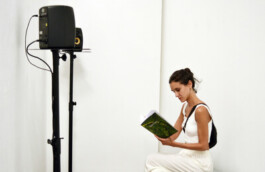Miriam Sentler studied at the art academy Maastricht (BFA FineArts,2016) and University of Amsterdam (MA Artistic Research, 2020).

Discipline
installation, video,
texts artist publications

»Miriam Sentler works within the fields of installation, video and artist publications. She is fascinated by the migration of natural and industrial objects and the human connection to landscapes, including how we treat the natural in light of practices of archiving, industry, and the colonial gaze. Exemplary, her ongoing project Building an Archive of a Disappearing Landscape (2018-ongoing), combines artistic work with theoretical research, exploring the changing of the landscape of Nordrhein-Westfalen in West-Germany due to lignite excavation. Her grandfather’s birthplace is now covered by a lake; this personal family history is placed within a larger Anthropogenic framework, relating the story to theories about landscape philosophy, material agency and the historicity of matter. Sacrifice is a central topic in Sentler’s work, where she questions if we should sacrifice nature and our natural habitats to build potentially better but also potentially planet-damaging habitats.«
– Marlies Augustijn, freelance curator, 2021.
Year of participation
2021
For the project Nieuwe Uitzichten, we (Deep Time Agency - Wouter Osterholt & Miriam Sentler) want to focus on the relationship between the river, the local community and the industrial heritage of Tegelen (Venlo).

Traditionally, large-scale ceramic factories produced tiles and bricks from clay that was mined from the local clay pits. The industry provided wealth and progress to the city and over time it became a vital part of local culture. However, there is a darker side to its success; the industrial ovens in the clay factories consumed a lot of energy, releasing considerable amounts of carbon dioxide. The climate crisis now increasingly affects our lives, as seen in the recent flooding in the area. Taking the future forecast of more flooding and natural disasters in the area due to climate change into account, in which many buildings, historical monuments and sites will eventually be taken ‘back’ by the water, we would like to bring an anthropogenic sacrifice to the river, an ancient tradition practiced by the early inhabitants of the river area. River offerings restored the relationship with the Gods since ancient times, taking into account a balance between the local community and the natural spirits. By bringing a sacrifice to the river, we aim to return something to the natural entity which has been damaged by centuries of industrial practice, treated as an excavation site by the local community.
Website

Miriam Sentler studied at the art academy Maastricht (BFA FineArts,2016) and University of Amsterdam (MA Artistic Research, 2020).

Discipline
installation, video,
texts artist publications
»Miriam Sentler works within the fields of installation, video and artist publications. She is fascinated by the migration of natural and industrial objects and the human connection to landscapes, including how we treat the natural in light of practices of archiving, industry, and the colonial gaze. Exemplary, her ongoing project Building an Archive of a Disappearing Landscape (2018-ongoing), combines artistic work with theoretical research, exploring the changing of the landscape of Nordrhein-Westfalen in West-Germany due to lignite excavation. Her grandfather’s birthplace is now covered by a lake; this personal family history is placed within a larger Anthropogenic framework, relating the story to theories about landscape philosophy, material agency and the historicity of matter. Sacrifice is a central topic in Sentler’s work, where she questions if we should sacrifice nature and our natural habitats to build potentially better but also potentially planet-damaging habitats.«
– Marlies Augustijn, freelance curator, 2021.

Year of participation
2021
For the project Nieuwe Uitzichten, we (Deep Time Agency - Wouter Osterholt & Miriam Sentler) want to focus on the relationship between the river, the local community and the industrial heritage of Tegelen (Venlo).
Traditionally, large-scale ceramic factories produced tiles and bricks from clay that was mined from the local clay pits. The industry provided wealth and progress to the city and over time it became a vital part of local culture. However, there is a darker side to its success; the industrial ovens in the clay factories consumed a lot of energy, releasing considerable amounts of carbon dioxide. The climate crisis now increasingly affects our lives, as seen in the recent flooding in the area. Taking the future forecast of more flooding and natural disasters in the area due to climate change into account, in which many buildings, historical monuments and sites will eventually be taken ‘back’ by the water, we would like to bring an anthropogenic sacrifice to the river, an ancient tradition practiced by the early inhabitants of the river area. River offerings restored the relationship with the Gods since ancient times, taking into account a balance between the local community and the natural spirits. By bringing a sacrifice to the river, we aim to return something to the natural entity which has been damaged by centuries of industrial practice, treated as an excavation site by the local community.